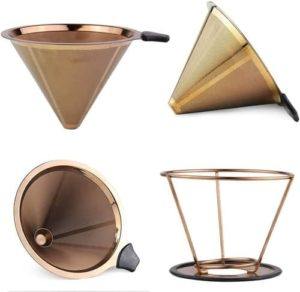Most people will know what a French Press is, but how do you actually use it, to make a great cup of really tasty coffee? That is what we are going to investigate and check out in this article.
The basics as you may already know are pretty simple. You put some coffee grains into the filter, pour on some hot water, leave for a few minutes, hit the plunger and pour the coffee. That sounds pretty easy so why make any fuss about it, you may well ask?
Well there is making coffee and then there is making great coffee. Let's have a look at the component parts.
- What Type of French Press Should You Use?
- What Type of Coffee Should You Use?
- What thickness of Grind Should You Use?
- What Temperature Should the Water Be?
- How Long Do You Brew it for?
- When Do You Actually Pour it?
- What brands of French Press Are There?
The Quick & Easy Way to Use a French Press
In the short two minute video below you will see how to use your French Press to make great tasting coffee.
Step by Step French Press Brewing Method
What Kit Do You Need?
- A Kettle
- A French Press
- Coffee - pre-ground (medium-coarse) OR Fresh roasted beans and a grinder
- A coffee scoop
- A mug for your coffee of course
The Brew
Step 1 - Boil the kettle and add a little hot water to the Press and to the mug just to warm them up
Step 2 - If you have beans then grind those to a medium coarse grind - if you have pre-ground then of course no need to do that
Step 3 - Add the coffee to the Press - 7 scoops (50 grams) for a 32 ounce press or to suit the size of your press
Step 4 - Two minutes after the kettle has boiled the temperature should be between 195-205 degrees Fahrenheit which is the "perfect" temperature (90.5 - 96 degrees Celsius)
Step 5 - Fill the Press half way with water - if it bubbles up you know you are using really fresh coffee
Step 6 - One minute later fill up the Press with water and put the lid on
Step 7 - Let the coffee brew for 3 minutes and then push the plunger down
Step 8 - Pour your French Press coffee and enjoy
So as you can see this brewing method is pretty simple. Well it is, so why I have added all the details shown above. Now you may well say that I am being far too fussy here, but I think those details are what separates a mediocre cup of coffee, from one that you will remember. So let's get started and you can at least see which parts are important to you.
So there are three main steps involved in this, which is the type of French Press that you use, the coffee itself and how it is ground, and then the actual brewing process. Let's start with that actual types of French Press available.

Different Types of French Presses
Most people will be familiar with the very classical style, which is a glass style that will have a lid and the plunger then is pushed down through the lid. These are inexpensive to buy and range from about £6-20, depending on what they are made from and what style they have.
There are also stainless steel versions which cost on average around £15-20.
They are often referred to as cafetiere or cafeteria style with the most popular size being 350 ml. These were patented by an Italian designer Attilio Calimani back in 1929 and were popular in design back in the 1950's. The name for these varies by country but the brewing principle is exactly the same.
It became very popular in Europe in the late 1950's and early 1960's and one manufacturer in particular, based in Denmark, became a popular choice. That company was called Bodum, and indeed in some countries, people talk about a Bodum coffee, rather than a French Press coffee.
Cheap vs Expensive French Presses
Like almost any other product there are cheap £5 versions of a French Press and more expensive ones. This comes down to a number of things.
The beaker, usually the shape of a cylinder can be made of plastic, glass or high quality glass.
The base and lid can be made of plastic, metal or stainless steel.
The plunger can fit loosely or tightly into the cylinder and the mesh can be made from a fine wire or from a plastic nylon material.
At the end of the day it is all about the quality and how much you want or can afford to pay.
Inexpensive



Higher End



Stainless Steel



The inexpensive ones can certainly make the coffee and for someone who just wants to have the odd cup they will certainly do the job. The higher end versions will last longer as they are made better, the vacuum is tighter so hold the temperature better, and generally speaking they look a lot more stylish.
For those that don't like the glass style, then the stainless steel versions are a better alternative. They will cost around the same price as a higher end glass one. After that it simply about picking the size of press that will suit you best.
They come in different sizes such as 350 ml which makes about 3 cups, 800 ml which makes about 6 cups and one litre which will make about 8 cups. So if you liked to serve this type of coffee at a party, you would need a bigger capacity. If it was just for a couple of people then the smaller capacity would be fine.
Here is a list of the Top 5 French Presses currently available in the UK.
French Presses for Campers and Hikers
You can also get specially made presses for those who like the outdoor life and enjoy hill climbing, hiking, and camping. Ideally these need to be lightweight and compact. I have done an article on presses for camping here.
Which Coffee and Which Grind?
Once you have sorted out which French Press will suit your needs the best, it is of course time to pick your coffee and then figure out how thick the grind should be. Let's start with the grind because irrespective of which coffee you pick, the important thing to know is that when making French Press coffee, it does require a medium coarse grind.
Pre-Ground vs Freshly Ground
Now it is a lot more convenient to buy the beans pre-ground in a shop or supermarket. The only problem with doing that is they they do not last that long. It is always best to buy the roasted beans, and then grind them when you need them. Beans last a lot longer that way, and there is nothing quite like the taste of freshly ground beans.
To do that of course will require a grinder and you can read some useful information about those by clicking here. I would recommend a burr grinder and you can read about those by clicking here. I have also done a full article on the best grinder for French Presses right here.
Water to Coffee Ratio for A Press



An easy way to remember how much coffee to use is to just remember this one thing. Use about 60-70 grams of coffee for each litre of water.
So for 350 ml French Press you would use about 20-25 grams of coffee. If you are using a scoop you just need to figure out how many grams are in a scoop.
Tip - one tablespoon of roasted beans per cup of water is what I use.
Which Coffee Beans?
Honestly it just depends on the type of coffee that you like. Almost always that is found by experimentation and trying out a few different blends until you find the one that you like. Almost any type works well in a press and it all comes down to your own personal taste and choice.
There is no one single best bean to use and I quite enjoy trying out different types.
And Finally Some French Press Brewing Tips
No matter how you make your coffee using this method, always watch out for the last mouthful. The filter or mesh in the plunger will do a good job of keeping the grains in the coffee, but there will almost always be the finger grains and powder that get through.
It does make the coffee feel stronger and thicker but I hate it when I forget I am drinking French Press and get a final mouthful of that. One thing I have noticed since I started using a burr grinder, is that the grind is a lot more even, and I get very little powder.
Water Temperature
I know it sounds a bit over the top to pour the water on at a certain temperature, but it does make a difference. if the water is poured straight from boiling I find it make the ground beans just a little more bitter.
The video below I would describe as the ultimate guide for those who want to include all of the details.
So there you have it folks and that should give you enough information on how to make great tasting coffee using the French Press method.






